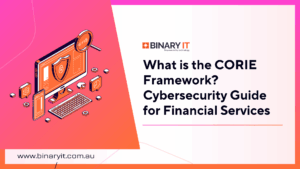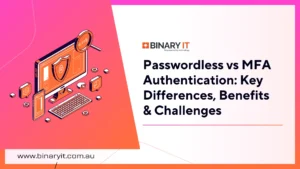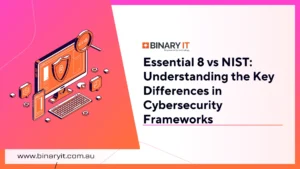What if I told you that your carefully chosen password, even that complex mix of symbols and numbers, might not be enough to keep your data safe?
In a digital world where cyberattacks happen every 39 seconds and billions of records are compromised every year, relying on password protection alone is a risk few can afford. Passwords are familiar and easy to use, but they’re also surprisingly easy to steal, guess, or crack.
That’s where encryption comes in: instead of just locking your digital door, it scrambles your data into unreadable code, useless to anyone without the right key. In this post, we’ll explore why encryption offers far stronger protection than passwords alone, how the two differ, and why the smartest approach is to combine them for truly resilient security.
What is Password Protection?
Password protection is the digital equivalent of putting a lock on your front door. When you password protect a file, application, or device, you’re essentially creating a checkpoint that requires the correct credentials before granting access. The password acts as a key; without it, legitimate users can’t enter, and unauthorised individuals are theoretically kept out.
Password protection is widely used across numerous applications and scenarios:
- Device access: Smartphones, tablets, laptops, and desktop computers typically require passwords, PINs, or biometric authentication to unlock
- File protection: Office documents, PDFs, and zip files can be password-protected to prevent unauthorised access
- Application security: Banking apps, email clients, and cloud storage services use passwords to verify user identity
- Account access: Online services from social media to shopping sites rely on password authentication
The appeal of password protection lies in its simplicity and familiarity. Most people understand the concept intuitively: you create a secret code, and only those who know it can access your protected content. However, this direct approach comes with significant limitations that become apparent when we examine how password security works.
What is Encryption?
Encryption takes data protection to an entirely different level. Rather than simply blocking access with a password, encryption transforms data into an unreadable, scrambled format. Think of it as converting your information into a secret code that looks like complete gibberish to anyone who doesn’t have the proper decryption key.
The encryption process uses complex mathematical algorithms to alter every piece of data systematically. Your original information, whether it’s a document, photo, or database, gets converted into what appears to be random characters and symbols. Without the correct decryption key, this scrambled data is virtually impossible to solve, even for skilled hackers with powerful computers.
Modern encryption typically comes in two main forms:
1. Symmetric encryption uses the same encryption key for both encrypting and decrypting data. It’s like having a special decoder ring that can both scramble and unscramble messages. This method is fast and efficient, making it ideal for safeguarding your data.
2. Asymmetric encryption uses a pair of keys, one public and one private. The public key can be shared openly and is used to encrypt data, while the private key remains secret and is used for decryption. This approach enables secure communication between parties who have never met or shared keys beforehand.
Unsure how to combine encryption and password policies effectively? Reach out to our team for expert guidance and practical solutions that keep your business data secure from every angle.
Encryption vs Password Protection: What’s the Difference?
Understanding the key differences between password protection and encryption is important for making informed decisions about protecting sensitive information:
| Aspect | Password Protection | Encryption |
|---|---|---|
| Level of Security | Offers moderate security by limiting who can open or use a file, app, or system. | Provides high security by transforming the original data into an unreadable format. |
| How Data is Protected | Relies on requiring the correct password to gain access to files or systems. | Uses cryptographic algorithms to scramble data so that it can only be read with the right key. |
| Vulnerability to Attacks | Vulnerable to brute force attacks, phishing, or stolen credentials, which can unlock the content. | Much harder to break; encrypted data remains protected even if someone obtains the file itself. |
| Data Visibility | Once someone bypasses or cracks the password, they can freely view and copy the data. | Data remains unreadable and useless to unauthorised users, even if they get hold of it. |
| Implementation Complexity | Generally easy to set up – most systems let you add or change passwords quickly. | Slightly more complex, though many modern tools and software make encryption straightforward for users. |
| Performance Impact | Usually has little to no impact on device or application performance. | May introduce a small processing delay when encrypting or decrypting data, but often unnoticeable. |
| Recovery Options | Forgotten passwords can often be reset or recovered through support tools or hints. | If encryption keys or certificates are lost, recovering the data can be very difficult or impossible. |
The most fundamental difference lies in what each method protects. Password protection is like having a bouncer at the door of a club; once someone gets past the bouncer (whether legitimately or not), they have full access to everything inside. Encryption, on the other hand, is like having everything inside the club written in an impenetrable code that only specific people can read.
Why Encryption is More Secure?
The superior security of encryption becomes clear when we examine what happens when security measures fail. Password protection creates a single point of failure; if someone discovers, steals, or cracks your password, they gain complete access to your protected data. Once inside, they can read, copy, modify, or delete your information just as easily as you can.
Even if hackers obtain your encrypted files, they can’t read the actual content without the decryption key. For broader protection, explore cybersecurity tools every Australian business should use.
Encryption offers multiple layers of protection that persist even when other security measures fail. Here’s why encryption is more secure:
Protection Against Data Breaches:
When cybercriminals breach a system and steal files protected by a password, they can often access the content immediately once they crack the passwords. With encrypted data, however, the stolen information remains useless, a scrambled text. Even if hackers obtain your encrypted files, they can’t read the actual content without the decryption key.
Resistance to Brute Force Attacks:
While passwords can be guessed, cracked, or obtained through social engineering, strong encryption keys are exponentially more difficult to break. Modern encryption algorithms like AES-256 would take billions of years to crack using current computing power, even with sophisticated attacks.
Data Integrity:
Encryption doesn’t just hide your data; it also helps ensure its integrity. Many encryption methods include mechanisms to detect if data has been tampered with, providing an additional layer of security that password protection alone cannot offer.
Protection During Transmission:
When you send password-protected files over email or upload them to cloud storage, the passwords often travel separately or may be stored in ways that compromise security. Encrypted data remains protected throughout transmission, regardless of how it’s sent or stored.
Defence Against Insider Threats:
Even trusted individuals with legitimate access to your systems can’t read encrypted data without the proper keys. This protection is important in business environments where multiple people may have administrative access to systems containing sensitive information.
Don’t leave your data exposed to modern cyber threats. Speak with our cybersecurity experts today to explore encryption solutions tailored to your organisation’s needs. Contact us now to get started.
Best Practices for Maximum Security
While encryption is more secure than password protection alone, the strongest security approach combines both methods. Here are the essential best practices for protecting your data:
1. Use Strong Passwords AND Encryption:
Don’t view these as competing options; they work together beautifully. Use strong, unique passwords to protect access to your encrypted data. This creates multiple barriers that attackers must overcome.
2. Enable Full-Disk Encryption:
Modern operating systems like Windows (BitLocker), macOS (FileVault), and Linux (LUKS) offer built-in full-disk encryption. This protects all data on your device, including temporary files and system data that individual file encryption might miss.
3. Encrypt Sensitive Files:
For individual files or folders containing sensitive information, use encryption software like 7-Zip, AxCrypt, or VeraCrypt. These tools make it easy to encrypt specific files without affecting your entire system.
4. Secure Your Encryption Keys:
Your encryption keys are as important as the data they protect. Store them securely, create backups, and never share them through insecure channels. Consider using a reputable password manager that supports encrypted storage for keys.
5. Keep Software Updated:
Security vulnerabilities in encryption software can compromise your protection. Regularly update your encryption tools and operating systems to ensure you have the latest security patches.
6. Use Multi-Factor Authentication:
When available, enable multi-factor authentication on encrypted storage services and devices. This adds another layer of security beyond just passwords.
7. Regular Security Audits:
Periodically audit your data protection practices. Identify sensitive information that isn’t encrypted and assess whether your current security measures are adequate for your needs.
Conclusion
While password security remains an important first line of defence, encryption provides the protection that today’s digital threats demand. Password protection is like locking your door; it keeps casual intruders out, but offers limited protection against determined attackers. Encryption is like having an invisible shield around your most valuable possessions that makes them useless to anyone who doesn’t have the right key.
The question isn’t whether to choose encryption vs password protection, it’s how to use both effectively. By combining strong passwords with strong encryption, you create a multi-layered security strategy that protects your data even when individual security measures fail. Whether you’re protecting personal memories, business documents, or sensitive customer information, encryption should be a cornerstone of your data security strategy.
The cost of inadequate data protection continues to rise. The time and effort invested in implementing proper encryption today can save you from potentially devastating losses tomorrow. Your data deserves the strongest protection available, and that protection is encryption. Contact us today to discuss customised encryption solutions and learn how we help businesses stay ahead of cyber risks every day.





